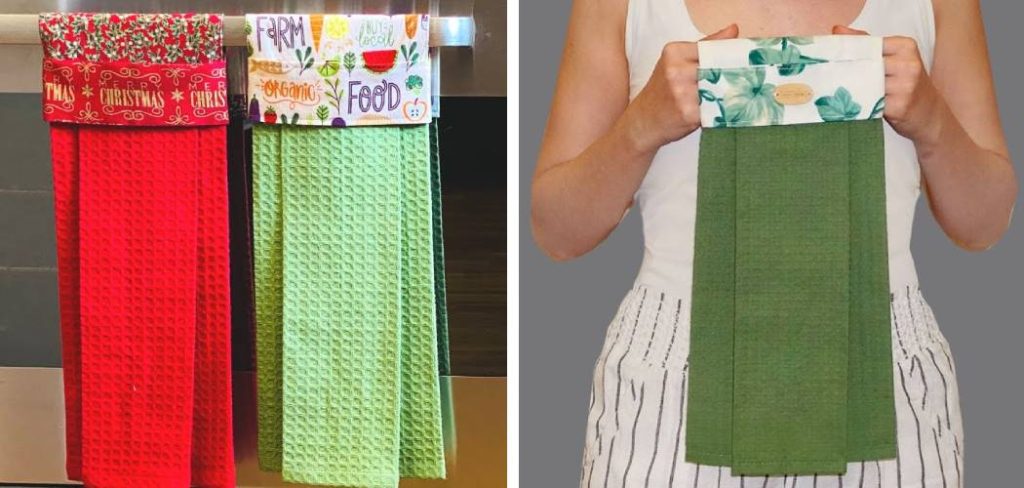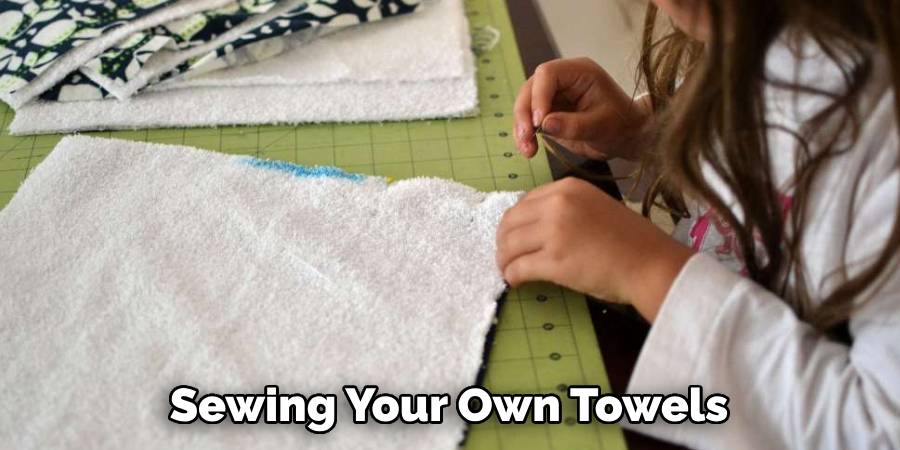Sewing your own kitchen towels is a fun and practical way to add some personal touches to your home. Not only can you choose the fabric and design, but homemade kitchen towels also make great gifts for friends and family. Whether you are an experienced seamstress or just starting out, this guide will walk you through the steps of how to sew kitchen towels.

What Type of Fabric is Best for Sewing Kitchen Towels?
When choosing fabric for your kitchen towels, there are a few things to keep in mind. First and foremost, you’ll want something that is absorbent and durable. This means avoiding fabrics that are too thin or slippery. Cotton is a great option as it is both absorbent and easy to work with. You can choose from a variety of patterns and prints to suit your personal style.
Materials Needed
Before you begin, make sure you have all the necessary materials. Here’s a list of what you’ll need:
- Cotton fabric
- Sewing machine
- Thread
- Scissors
- Pins
- Measuring tape or ruler
- Iron and ironing board
Top 10 Sewing Tips for Homemade Kitchen Towels
Sewing your own kitchen towels is a delightful way to add a personal touch to one of the most used items in your home. Not only is it a creative and rewarding activity, but it also allows you to customize the fabric, size, and style to match your kitchen aesthetic perfectly. Whether you’re an experienced seamstress or a complete beginner, these top 10 sewing tips will guide you through the process with ease and help you make kitchen towels you’ll be proud to display.
1. Gather the Right Materials
Before you begin, gather all the materials you’ll need. You’ll require fabric—cotton is a popular choice for kitchen towels due to its absorbency and durability. A good-quality thread that matches your fabric is essential. Don’t skimp on your thread; kitchen towels endure a lot of washing, so you want a strong thread that won’t break down quickly. You’ll also need sewing scissors, pins, an iron and ironing board, a measuring tape, and a sewing machine.

2. Select the Ideal Fabric
The type of fabric you choose for your kitchen towels is crucial. Consider the primary use of your towels – is it for drying dishes or hands? Woven cotton fabrics like flour sack cloths, muslin, or even recycled linen are excellent choices for their absorbency and resistance to wear and tear. They are also easy to sew and become more absorbent with each wash.
3. Pre-Wash Your Fabric
Always pre-wash and dry your fabric before you start cutting and sewing. This step is imperative as it will allow your fabric to shrink prior to sewing, preventing your finished towels from unexpected changes in size after laundering. Pre-washing will also remove any sizing and prepare the fabric to be most water-absorbent.
4. Measure Carefully
Accurate measuring is key. Decide on the finished size of your towels and add the seam allowance. For example, if you want a 12-inch square towel with ¼ inch seams, you’ll cut your fabric 13 inches square. Remember to measure twice and cut once to avoid mistakes and wasted fabric. If you’re a beginner, consider using a self-healing cutting mat and a rotary cutter for straight edges.
5. Use a Straight and Even Stitch
When sewing your kitchen towels, use a straight stitch for most of the sewing. This stitch is the most secure for edges and hems. Ensure that your stitches are even, as inconsistencies can affect the towel’s durability and final look. Use the presser foot as a guide to help you stitch straight, and practice on scrap fabric if needed.

6. Reinforce the Corners
Kitchen towels, particularly those used for drying, can experience a lot of pulling, so corner reinforcement is a smart move. This can be done by backstitching at corners or by creating a triangle at each corner when you sew the hems. These small steps can significantly increase the lifespan of your towels.
7. Press Your Seams
Pressing your seams after sewing is just as important as the sewing itself. It will make your towel lay flat, give it a professional look, and make subsequent sewing steps easier. Always press open the seams to reduce bulk. A tip is to use a pressing cloth to avoid shiny iron marks on your fabric.
8. Use Coordinating or Contrasting Thread
The thread you choose can greatly influence the design of your towel. Coordinating thread will blend in and create a subtle look, whereas contrasting thread can make a bold statement. Experiment with different thread colors and even variegated threads for a unique touch. Just ensure the thread is of good quality and appropriate for the fabric.
9. Consider Decorative Options
Sewing your own towels gives you the freedom to add decorative elements. You can embroider a monogram, sew on a fabric strip, or add a ruffle for a decorative touch. Be creative and remember that the beauty of handmade items lies in the individual details.

10. Enjoy the Process
Sewing kitchen towels should be an enjoyable process. Take your time, enjoy the rhythm of the machine, and relish in the satisfaction of creating something functional with your own two hands. Not every seam has to be perfect, and every towel you make will be a little reminder of the love and care that went into making it.
Sewing your own kitchen towels is not only a practical choice but also a sustainable one, as it reduces waste and allows you to upcycle old fabrics. With these top 10 tips, your sewing project is sure to be a success, and you’ll be well on your way to having an eco-friendly and stylish kitchen.
5 Things You Can Do With Your Homemade Kitchen Towels
So, you’ve successfully sewn your own kitchen towels – now what? Here are five fun and practical ways to use your new handmade creations:
- Dry Dishes and Hands: The most obvious use for kitchen towels is to dry dishes and hands. Hang them over your oven door or a towel rack for easy access.
- Line Bread Baskets: Use a kitchen towel to line your bread basket and keep freshly baked bread warm for longer.
- Wrap Homemade Gifts: Save on gift wrap by using your kitchen towels to wrap homemade goodies like cookies, jam, or wine bottles.
- Protect Surfaces: Place a kitchen towel under hot dishes to protect your table or countertops from heat damage.
- Decorative Display: Show off your beautiful handmade towels by displaying them on hooks or in a decorative basket in your kitchen. They can add a pop of color and personality to the room.
Remember, these are just a few suggestions – get creative and find even more uses for your homemade kitchen towels! With their durability and customizable design, they make perfect gifts for friends and family, or a lovely addition to your own home.

Frequently Asked Questions
What is the Best Material for Kitchen Towels?
When considering the best material for kitchen towels, it’s essential to look for a fabric that is absorbent, durable, and easy to clean. For those who are keen on crafting their own, understanding how to sew kitchen towels becomes equally important. Cotton is often the top choice due to its superior absorbency and strength, especially when in a terrycloth weave which increases its moisture-wicking capabilities.
Linen kitchen towels are another popular option, prized for their natural antibacterial properties and a quicker drying time. While selecting the material, keep in mind that the fabric should withstand frequent washes and resist wear and tear. Whether you’re purchasing premade towels or creating bespoke ones, choosing the right material will ensure that your kitchen towels are both functional and long-lasting.
How Do You Tie Kitchen Towels?
Tying kitchen towels is a quick and easy way to secure them onto oven handles or towel racks. To tie a kitchen towel, first fold it in half lengthwise and then again crosswise. Next, place the center of the towel on top of your oven handle or towel rack, making sure that the ends are even. Bring one end over the handle and through the loop created by the towel’s fold. Repeat with the other end, pulling it through the loop in the opposite direction. Adjust as needed to ensure that the towel is securely tied and ready for use.
Can You Embroider on Kitchen Towels?
Yes, you can embroider on kitchen towels! Embroidery adds a personal touch and can elevate the look of any plain towel. When considering embroidering on your towels, keep in mind that it’s best to use a stabilizer underneath the fabric to prevent puckering and ensure clean stitching. It’s also helpful to transfer your design onto the towel using a washable fabric pen or pencil. With a little practice and creativity, you can create beautiful embroidered kitchen towels that make great gifts or additions to your own home.
Conclusion
In this guide, we’ve covered the top 10 sewing tips for how to sew kitchen towels. From selecting the right materials to adding decorative elements, following these tips will help you create functional and stylish towels that you’ll be proud to use in your kitchen. Remember to enjoy the process and have fun with it – after all, handmade items are unique and special because of the love and care that goes into making them. So, gather your supplies, fire up your sewing machine, and get ready to create some beautiful and eco-friendly kitchen towels! Happy sewing!
